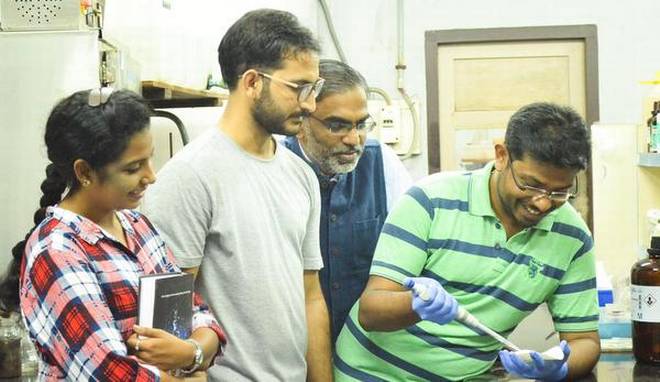
The material can be coated on a variety of surfaces including glass and paper
Nanocellulose-based liquid dispersion that renders the coated surface extremely water repellent — superhydrophobic with water contact angle more than 160 degrees — has been developed by a team of researchers led by Prof. T. Pradeep from the Department of Chemistry at the Indian Institute of Technology (IIT) Madras.
The material can be coated on a variety of surfaces including glass and paper. It has several distinct properties such as high mechanical durability and chemical stability. Like other superhydrophobic materials, the dispersion-coated surface exhibits microbial resistance thus preventing biofouling.
The researchers used cellulose nanofibres (5-20 nm wide and more than 500 nm in length) and functionalised them with flurosilane in water over six-seven hours at room temperature. The linkage of fluorosilane with cellulose happens through the hydroxyl groups present on cellulose.
The functionalisation makes the long fibres of cellulose, resembling bamboo poles of molecular dimensions, to be covered with fluoroalkyl groups. This reduces the surface energy of cellulose fibres. Low surface energy together with enhanced surface roughness at nanoscale renders the coated surface highly water-repellent. Tiny water droplets dropped from a height bounced off the coated surface attesting the extreme water-repellence. Other tests too confirmed superhydrophobicity.
“The functionalisation process avoids the use of organic solvents. This makes it safe and eco-friendly. This science helps expand the use of sustainable materials. And similar to water, the dispersion is not sticky thus making it easy to coat or spray paint on any surface,” says Prof. Pradeep.
Superior durability
The coating exhibited superior mechanical durability even when subjected to a variety of abrasion tests — scratches using a knife, peel-off test and sand paper abrasion. “There was negligible reduction in water repellence even when subjected to wear and tear. The covalent linkages between the cellulose fibres provide superior mechanical stability to the coating,” Prof. Pradeep says. The coating also strongly adheres to the surface.
Even when exposed to organic solvents such as hexane and ethanol, the coating exhibited chemical stability and retained its extreme water-repelling property. “The coating absorbs organic solvents. Once the coating dries, which happens very quickly, the water-repelling property returns,” says Avijit Baidya from the Department of Chemistry, IIT Madras and the first author of the paper published in the journal ACS Nano.
“The coating remained stable even when subjected to extreme temperatures of 200 degree and –80 degree and exposed to direct sunlight,” says Baidya. “The longevity was also tested for two years under laboratory conditions.”
Despite the extreme water repelling property, coated paper absorbs organic components. “Since ink has organic components, the coating allows the ink to diffuse. Unlike normal paper where the ink washes off when exposed to water, the ink on the coated paper remained intact even when in contact with water,” says Baidya.
Though the coating strongly adheres to glass and exhibits all the desirable properties, light transmission gets compromised as the coating turns the glass white. “This material is truly not for glass. Better applications will be in paints and for coating the paper used for printing currency,” says Baidya.
The team is already working to address the issue of light transmission by using a starting material other than cellulose. “We have nearly developed a superhydrophobic material that remains transparent once coated,” says Prof. Pradeep, who is the corresponding author.
“We are willing to commercialise the product either through a start-up or by licensing it. We have already filed for a patent,” He says.
source: http://www.thehindu.com / The Hindu / Home> Sci-Tech> Science / by R Prasad / October 28th, 2017